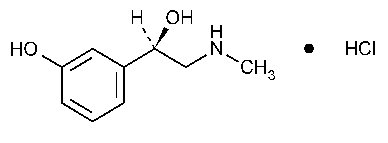Phenylephrine Hydrochloride
Benzenemethanol,3-hydroxy-a-[(methylamino)methyl]-,hydrochloride (R)-.
(-)-m-Hydroxy-a-[(methylamino)methyl]benzyl alcohol hydrochloride [61-76-7].
»Phenylephrine Hydrochloride contains not less than 97.5percent and not more than 102.5percent of C9H13NO2·HCl,calculated on the dried basis.
Packaging and storage—
Preserve in tight,light-resistant containers.Store at 25 ,excursions permitted between 15
,excursions permitted between 15 and 30
and 30 .
.
Identification—
A:Infrared Absorption á197Kñ.
B:
Asolution (1in 100)responds to the tests for Chloride á191ñ.
Loss on drying á731ñ—
Dry it at 105 for 2hours:it loses not more than 1.0%of its weight.
for 2hours:it loses not more than 1.0%of its weight.
Residue on ignition á281ñ:
not more than 0.2%.
Sulfate á221ñ—
Asolution of 50mg in 25mLof water shows no more turbidity than corresponds to 0.10mLof 0.020Nsulfuric acid (0.20%).
Limit of ketones—
Dissolve 200mg in 1mLof water,add 2drops of sodium nitroferricyanide TS,then add 1mLof 1Nsodium hydroxide,followed by 0.6mLof glacial acetic acid:the color of the final solution is not deeper than that obtained in a control solution prepared with 1mLof dilute acetone (1in 2000).
Chromatographic purity—
Standard preparations—
Dissolve an accurately weighed quantity of USP Phenylephrine Hydrochloride RSin methanol to obtain a solution having a known concentration of 1mg per mL.Quantitatively dilute with methanol to obtain Standard preparationshaving the following compositions:
| Standard Preparation |
Dilution | Concentration (µg RS per mL) |
Percentage (%, for comparison with test specimen) |
| A | (1in 2) | 500 | 1.0 |
| B | (1in 4) | 250 | 0.5 |
| C | (1in 10) | 100 | 0.2 |
| D | (1in 20) | 50 | 0.1 |
Test preparation—
Dissolve an accurately weighed quantity of Phenylephrine Hydrochloride in methanol to obtain a solution containing 50mg per mL.
Procedure—
Apply separately 5µLof the Test preparationand 5µLof each Standard preparationto a suitable thin-layer chromatographic plate (see Chromatography á621ñ)coated with a 0.25-mm layer of chromatographic silica gel mixture.Position the plate in a chromatographic chamber and develop the chromatograms in a solvent system consisting of a mixture of n-butyl alcohol,water,and formic acid (7:2:1)until the solvent front has moved about three-fourths of the length of the plate.Remove the plate from the developing chamber,mark the solvent front,and allow the solvent to evaporate in warm,circulating air.Examine the plate under short-wavelength UVlight.Then spray the plate with a saturated solution of p-nitrobenzenediazonium tetrafluoroborate followed by sodium carbonate solution (1in 10).Compare the intensities of any secondary spots observed in the chromatogram of the Test preparationwith those of the principal spots in the chromatograms of the Standard preparations:the sum of the intensities of secondary spots obtained from the Test preparationcorresponds to not more than 1.0%of related compounds,with no single impurity corresponding to more than 0.5%.
Chloride content—
Dissolve about 300mg,accurately weighed,in 5mLof water.Add 5mLof glacial acetic acid and 50mLof methanol,then add eosin Y TS,and titrate with 0.1Nsilver nitrate VS.Each mLof 0.1Nsilver nitrate is equivalent to 3.545mg of Cl.Not less than 17.0%and not more than 17.7%of Cl is found,calculated on the dried basis.
Assay—
Dissolve about 100mg of Phenylephrine Hydrochloride,accurately weighed,in 20mLof water contained in an iodine flask,add 50.0mLof 0.1Nbromine VS,then add 5mLof hydrochloric acid,and immediately insert the stopper.Shake the flask,and allow to stand for 15minutes.Introduce quickly 10mLof potassium iodide solution (1in 10),allow to stand for 5minutes,shake thoroughly,remove the stopper,and rinse it and the neck of the flask with a small quantity of water into the flask.Titrate the liberated iodine with 0.1Nsodium thiosulfate VS,adding 3mLof starch TSas the endpoint is approached.Perform a blank determination (see Residual Titrationsunder Titrimetry á541ñ).Each mLof 0.1Nbromine is equivalent to 3.395mg of C9H13NO2·HCl.
Auxiliary Information—
Staff Liaison:Daniel K.Bempong,Ph.D.,Scientist
Expert Committee:(PA2)Pharmaceutical Analysis 2
USP28–NF23Page 1541
Pharmacopeial Forum:Volume No.29(6)Page 1964
Phone Number:1-301-816-8143
